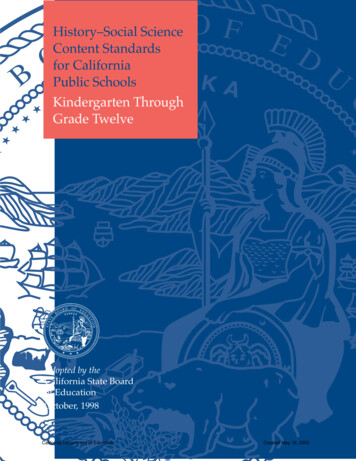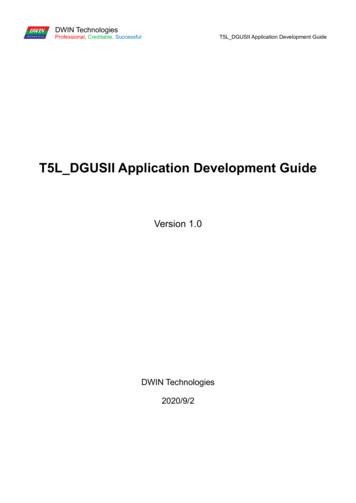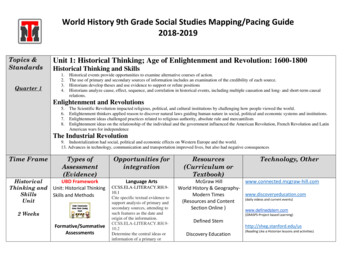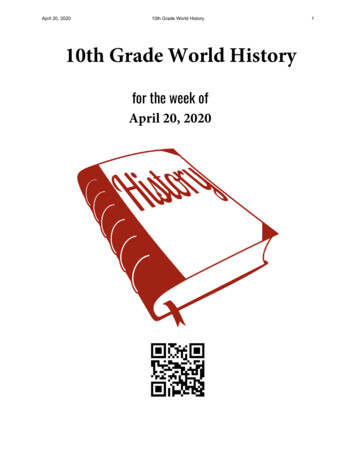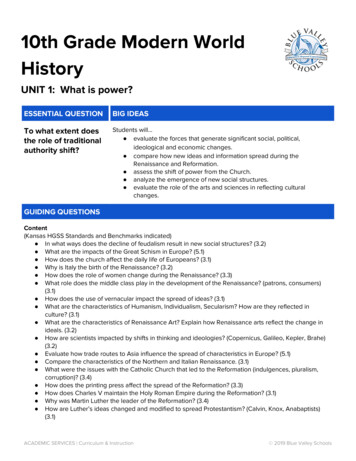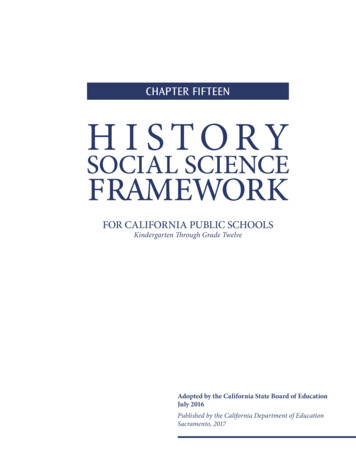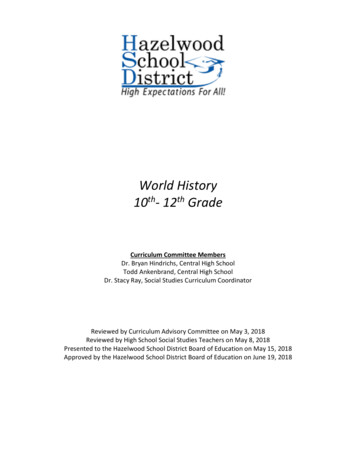
Transcription
World History10th- 12th GradeCurriculum Committee MembersDr. Bryan Hindrichs, Central High SchoolTodd Ankenbrand, Central High SchoolDr. Stacy Ray, Social Studies Curriculum CoordinatorReviewed by Curriculum Advisory Committee on May 3, 2018Reviewed by High School Social Studies Teachers on May 8, 2018Presented to the Hazelwood School District Board of Education on May 15, 2018Approved by the Hazelwood School District Board of Education on June 19, 2018
TABLE OF CONTENTSWorld HistoryHazelwood School District Mission Statement . 3Hazelwood School District Vision Statement .3Hazelwood School District Goals .3Curriculum Overview .4Course Overview .6Recommended Pacing Guide .6World History Curriculum – Unit 1 . Page 13World History Curriculum – Unit 2 . Page 126World History Curriculum – Unit 3 . Page 198World History Curriculum – Unit 4 . Page 237World History Curriculum – Unit 5 . Page 284World History Curriculum – Unit 6 . Page 366World History Curriculum – Unit 7 . Page 417World History Curriculum – Unit 8 . Page 467World History Curriculum – Unit 9 . Page 568
Hazelwood School DistrictMission StatementWe are a collaborative learning community guided by a relentless focus to ensureeach student achieves maximum growth.Vision StatementHSD will foster lifelong learners, productive citizens and responsible leaders for anever-evolving society.Board of Education on January 5, 2010GoalsGoal # 1: Hazelwood students will meet or exceed state standards in all curricularareas, with emphasis in reading, writing, mathematics, science and social studies.Goal # 2: Hazelwood staff will acquire and apply the skills necessary for improvingstudent achievement.Goal #3: Hazelwood School District, the community and all families will supportthe learning of all children.3
Curriculum OverviewCurrent State End of Course (EOC) assessment scores for social studies indicate a need forstrengthening social studies instruction at all levels. While Hazelwood scores have risen sincethe 2011-2012 school year, in 2017 the state scores show 18.8% more students scoringproficient statewide than Hazelwood students (51.3 % compared to 63.6 %).Below is the data comparing the state and Hazelwood students scoring advanced and proficientfrom the 2011-2012 school year through the 2016-2017 school year.The curriculum committee researched best practices in social studies education prior to writingthe new curriculum; therefore, the new curriculum is designed to enhance the rigor of thesocial studies disciplines and to build critical thinking, problem solving, and participatory skillsallowing students to become engaged citizens.World history is a comprehensive curriculum on the human past. It is distinct fromcurricula that emphasize a sequence of regions and civilizations. The world historycurriculum emphasizes skills in historical thinking, a chronological approach to thehuman past, multiple scales of social activity, interactions among groups of people andsocial processes, and the identification of multiple perspectives on the past. Thecurriculum explores social change, cultural interaction, and economic and politicaldevelopment. It presents an orderly exploration of multiple spheres of history andscientific inquiry. At the same time the curriculum addresses conflict as well ascooperation in the past, and explores debate as well as consensus.-Alliance for Learning in World History, 2017The new curriculum is a melding of the new Missouri Learning Standards (adopted in May of2016) and the College, Career, and Civic Life (C3) Framework for Social Studies Standards4
developed by the National Council for the Social Studies, in partnership with the NationalCenter for Literacy Education (NCLE).The College, Career, and Civic Life (C3) Framework is driven by the following shared principlesabout high quality social studies education: Social studies prepares the nation’s young people for college, careers, and civic life. Inquiry is at the heart of social studies. Social studies involves interdisciplinary applications and welcomes integration of thearts and humanities. Social studies is composed of deep and enduring understandings, concepts, and skillsfrom the disciplines. Social studies emphasizes skills and practices as preparation fordemocratic decision-making. Social studies education should have direct and explicit connections to Standards forEnglish Language Arts.NCSS, 2010In addition to the increased rigor and critical thinking skills of the C3 Framework, the curriculumis aligned to the 2016 Missouri Learning Standards. The curriculum meets all of the state anddistrict requirements for research, technology, literacy, gender equality, English LanguageLearners, racial equality, and disability awareness.The curriculum contains required assessments and suggested learning activities. Teachers areencouraged to select activities reflecting the needs and abilities of their students. Although thelearning activities are suggested, completion of the activities will prepare students to besuccessful on the required district assessments.5
COURSE TITLE: World HistoryGRADE LEVEL: 10th – 12th GradeCourse Description:This course requires students to examine world history from The Renaissance through moderntimes. Students will examine the major events, movements, and issues which have shapedthe world. Included are evaluation of The Renaissance, Exploration, The Enlightenment,worldwide revolutions, World War I, Depression Era, World War II, Cold War, and thephilosophical attitudes through present day. Students will acquire an understanding of theforces shaping the world in which they live. Students use reading and writing strategies,analyze primary and secondary source material, use research and information skills, andactively engage in evaluation, analysis, and synthesis of historical events.Course Rationale:Social studies creates students who learn skills ranging from reading a map to framing anargument, and it teaches students to assess the validity of evidence, evaluate conflictingpoints of view and apply facts in order to make decisions and articulate compellingarguments. These real world skills enable students to become critical thinkers, independentlearners, problem solvers, and effective communicators so that they will be able to acquireinformation, an understanding of cultural diversity, and the skills necessary to become fullparticipants in our democratic society.Unit 1The World beforeModern TimesCourse Scope and SequenceUnit 2Unit 3Renaissance,Age of DiscoveryReformation andScienceUnit 4The Enlightenment10 sessionsof 90 minutes8 sessionsof 90 minutes6 sessionsof 90 minutes6 sessionsof 90 minutesUnit 5Age of RevolutionsUnit 6ImperialismUnit 7WWIUnit 8WWII10 sessionsof 90 minutesUnit 9Post World War II6 sessionsof 90 minutes8 sessionsof 90 minutes14 sessionsof 90 minutes12 sessionsof 90 minutes6
Unit ObjectivesUnit 11. Students will be able to explain the causes and effects of the expansion of societies inWestern Africa, Byzantine Empire, Gupta India, Chinese Dynasties, and Muslim Empires.2. Students will be able to compare the dominant characteristics, contributions of, andinteractions among major civilizations of Asia, Europe, Africa, the Americas, and Middle Eastin ancient and medieval times.3. Students will be able to compare and contrast governmental systems, including monarchy,oligarchy, dynasty, and theocracy.4. Students will be able to explain the influence of the classical revival on governmentalsystems including their source of power, how leaders are selected, and how decisions aremade.5. Students will be able to analyze physical geography to explain how regions are connected orisolated from each other.6. Students will be able to compare and contrast regions by examining the culturalcharacteristics of European, African, Asian, and American societies.7. Students will be able to analyze the flow of goods and ideas along ocean and overland traderoutes to explain their contributions to economic success or failures of societies in Europe,Africa, Middle East, India, the Americas, and China.8. Students will be able to explain how scientific and technological advancements impactedthe interconnectedness within and among regions.9. Students will be able to analyze the historic rise of Islam, as well as the expansion ofChristianity, Islam, and Buddhism in order to explain their transformations and roles in conflictand cooperation.Unit 21. Students will be able to explain how the Crusades, Black Death, and the resulting exchangesthat followed, impacted Europe and led to the Renaissance.2. Students will be able to analyze the intellectual, architectural, and artistic achievements ofthe Renaissance resulting from the rebirth of Classical ideas.3. Students will be able to analyze the historical context of the Protestant Reformation andScientific Revolution to explain new institutions and ways of thinking and explain their social,political and economic impact.4. Students will be able to trace the development and impact of religious reform onexploration and conflicts among groups and nations.Unit 31. Students will analyze the causes and consequences of European overseas expansion todetermine its effect on peoples and cultures in Europe, Asia, Africa, and the Americas.2. Students will explain the challenges and benefits of large land empires including thosefound in Russia, China, and the Middle East.3. Students will analyze physical geography to explain the availability and movement ofresources.4. Students will describe major changes in patterns of migration and human settlement inAfrica, Asia and the Americas resulting from European expansion.5. Students will compare the extent and impacts of African, European, American, and Asiantrade networks.7
6. Students will compare the origins, development, and effects of coerced labor systems inAsia, Africa, Europe, and the Americas7. Students will describe how new sources of wealth resulting from global interactionimpacted cultures and civilizations.8. Students will analyze the exchange of people, goods, and ideas to determine their impacton global interdependence and conflict.9. Students will determine the extent and impact of cultural exchange, interaction, anddisruption that resulted from the Columbian Exchange and European expansion in the Easternand Western Hemispheres.Unit 41. Students will describe how governments and governmental institutions of the Eastern andWestern Hemispheres changed to deal with the challenges and opportunities of aninterconnected world.2. Students will analyze the style and function of a leader to determine their impact on agovernmental system.3. Students will assess the roles of class, ethnic/racial groups, gender, and age to determine aperson’s roles in society and social institutions.4. Students will analyze the key ideas of Enlightenment thinkers to explain the development ofideas such as natural law, natural rights, social contract, due process, and separation ofpower.5. Students will compare and contrast limited and absolute governments and the extent oftheir impact on individuals and society.6. Students will analyze the intellectual, artistic, and literary achievements of theEnlightenment to determine how they challenged the status quo.Unit 51. Students will evaluate the forms of republics over time to determine their implication forpre-revolutionary ideas and expectations during the Age of Revolution.2. Students will compare and contrast causes and significant outcomes of political revolutionsduring this era. (e.g., Glorious Revolution, American Revolution, French Revolution, Haitianand Latin American Revolutions).3. Students will analyze political revolutions and reform movements in order to determinetheir enduring effects worldwide on the political expectations for self-government andindividual liberty.4. Students will compare and contrast government systems resulting from politicalrevolutions.5. Students will explain how and why places changed as a result of revolutions and why peopleperceived the same place in varied ways.6. Students will extrapolate the push-pull factors created by revolutions to determine theirimpacts on population distribution, settlements, and migrations.7. Students will explain the significance of new technologies in expanding peoples’ capacity tomodify the physical environment and their consequences.8. Students will analyze the origins and characteristics of laissez faire, market, mixed, andcommand economic systems to determine their effects on personal, social, and politicaldecisions.8
9. Students will examine the connections among natural resources, entrepreneurship,innovation, labor, and capital to determine their effects on an industrial economy in Europe,Africa, Asia, and the Americas.10. Students will analyze new technologies and forms of energy to determine their effects onthe lives of individuals, groups, and societal organization.11. Students will analyze social and educational reform movements to determine their impacton the challenges brought about by revolutions.12. Students will analyze political, social, cultural, artistic, and economic revolutions todetermine how they impacted the concepts of class, race, tribe, slavery, and caste affiliation.13. Students will analyze reactions to revolutions in order to predict future conflicts.Unit 61. Students will evaluate the impact of nationalism on existing and emerging peoples andnations post c. 1450.2. Students will analyze world-wide imperialism in the late 19th and early 20th centuries todetermine its causes and consequences.3. Students will trace the origins, and relationships among the world wars, revolutions, andglobal conflicts of 20th century to determine their impacts on the world today.4. Students will analyze the process of globalization to determine its effect on global conflictand cooperation.Unit 71. Students will analyze world-wide imperialism in the late 19th and early 20th centuries todetermine its causes and consequences.2. Students will trace the origins and relationships among the world wars, revolutions, andglobal conflicts of 20th century to determine their impacts on the world today.3. Students will analyze treaties, agreements, and international organizations to determinetheir impact on world challenges along with national and international order.4. Students will analyze physical geography to explain the availability and movement ofresources.5. Students will explain how technology has reduced barriers and expanded peoples’ capacityto make use of, or modify, the physical environment.6. Students will evaluate the relationship between technological and scientific advancements(e.g., communication, transportation, production) and increasing global interaction.7. Students will analyze economic systems (e.g., market, mixed, command) to determine theirimpact on economic growth, labor markets, rights of citizens, the environment, and resourceallocation in and among regions.8. Students will analyze the process of globalization to determine its effect on global conflictand cooperation.9. Students will evaluate the powers and responsibilities of citizens and institutions to addressand solve world problems c. post 1450.Unit 81. Students will trace the origins, and relationships among the world wars, revolutions, andglobal conflicts of twentieth century to determine their impacts on the world today.2. Students will compare and contrast evolving governmental systems, including monarchy,totalitarianism, theocracy, and representative government to determine their impact onsociety.9
3. Students will analyze treaties, agreements, and international organizations to determinetheir impact on world challenges along with national and international order.4. Students will evaluate the response of individuals, groups, and governments to economic,environmental, health, and medical challenges to understand how systems change and evolveover time.5. Students will analyze causes and patterns of human rights violations and genocide andsuggest resolutions for current and future conflicts.6. Students will evaluate the powers and responsibilities of citizens and institutions to addressand solve world problems.7. Students will analyze the technological, intellectual, artistic, and literary achievements ofthe modern era to determine how society reflects and challenges the status quo.8. Students will analyze the causes and effects of the changing roles of class, ethnicity, race,gender and age on world cultures post c. 1450.Unit 91. Students will trace the origins, and relationships among the world wars, revolutions, andglobal conflicts of 20th century to determine their impacts on the world today.2. Students will analyze the varying processes of decolonization to compare its effects on theworld today.3. Students will compare and contrast evolving governmental systems, including monarchy,totalitarianism, theocracy, and representative government to determine their impact onsociety.4. Students will analyze treaties, agreements, and international organizations to determinetheir impact on world challenges along with national and international order.5. Students will evaluate the relationship between technological and scientific advancements(e.g., communication, transportation, production) and increasing global interaction.6. Students will evaluate the response of individuals, groups, and governments to economic,environmental, health, and medical challenges to understand how systems change and evolveover time.7. Students will analyze causes and patterns of human rights violations and genocide andsuggest resolutions for current and future conflicts.8. Students will analyze the technological, intellectual, artistic, and literary achievements ofthe modern era to determine how society reflects and challenges the status quo.9. Students will evaluate the powers and responsibilities of citizens and institutions to addressand solve world problems c. post 1450.10
Essential Terminology/VocabularyUnit 1Anarchy, Buddhism, Christianity, construct, dictatorship, diffusion, direct democracy, empire, Islam,Judaism, monarchy, monotheistic, oligarchy, polytheistic, representative democracy, SPICE andtheocracy.Unit 2Catholic, geocentric, heliocentric, heresy, humanism, Indulgences, Protestant, Reformation,Renaissance, and vernacular.Unit 3Columbian Exchange, indigenous, mercantilism and Triangle Trade.Unit 4Absolutism, Consent of the governed, Divine Right, Due process, Natural rights, Separation of powers,Social Contract, Status quo and Unalienable rights.Unit 5Absolutism, capital, command economy, labor, laissez faire, market economy, mixed economy,nationalism and revolution.Unit 6Alliances, ethnocentrism, imperialism and nationalism.Unit 7Alliances, Capitalism, Communism, Imperialism, Militarism, Nationalism, Socialism, Triple Alliance andTriple Entente.Unit 8Adolf Hitler, appeasement, Axis Powers, Benito Mussolini, Franklin Roosevelt, genocide, Hideki Tojo,Hiroshima, interment, island hopping, Joseph Stalin, Lend Lease Act, Manhattan Project, MunichAgreement, Nagasaki, totalitarian, Winston Churchill, and Yalta Conference.Unit 99/11, Al-Qaeda, Axis of Evil, Brinkmanship, Cold War, Globalization, Homeland Security, Patriot Act,and Taliban.Proposed Course Materials and Resources: World States History & Geography: Modern Times, McGraw-Hill Education 2018.ISBN: 978-0-07-676824-0 Print and Online text and resources11
COURSE TITLE: World History GRADE LEVEL: 10th – 12th Grade Course Description: This course requires students to examine world history from The Renaissance through modern times. Students will examine the major events, movements, and issues which have shaped the world. Included are evalu




